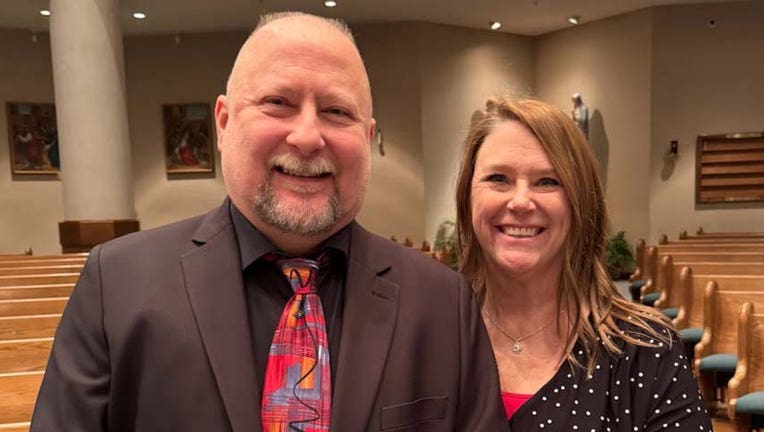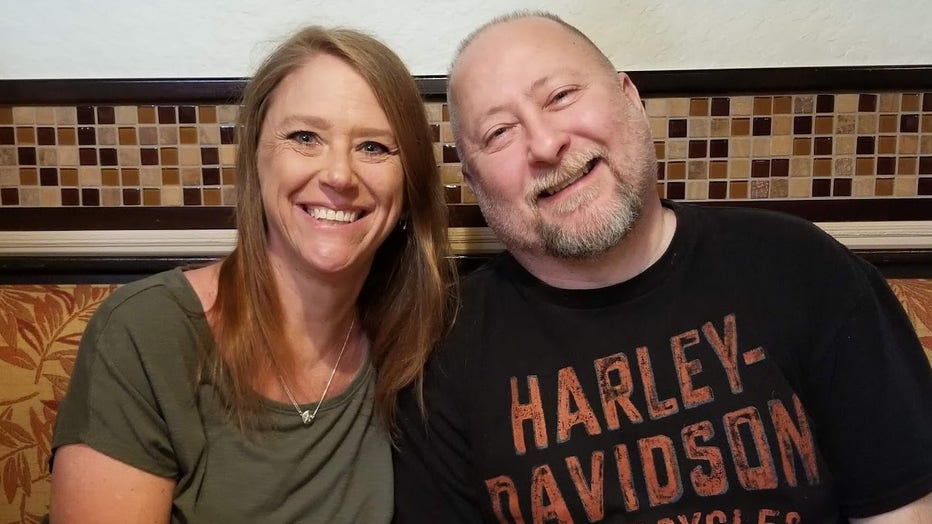Eloping under the eclipse: Couples to get hitched during rare solar event

Jenny Harris and Bart Lombardy have decided to elope underneath the total lunar eclipse. (Credit: Jenny Harris)
FOSTORIA, Ohio - Hundreds of couples have decided to tie the knot underneath the total lunar eclipse next month.
Jenny Harris and her fiancé Bart Lombardy of Ohio are among those couples.
They’ll take part in Seneca County’s "Elope at the Eclipse," where couples are invited to say their vows underneath the celestial event in northwest Ohio.
Harris and Lombardy have been together for 10 years, being engaged for the past two. Picking a wedding date has been a challenge for them, so they chose the county’s April 8 event, saying the eclipse is "the icing on the cake."
RELATED: How to watch the total solar eclipse with NASA
"This is just so simple and such a unique and wonderful idea," Harris told FOX Television Stations. "Just the fact that it is something so unique and, you know, something that everyone will remember."

Anatomy of a solar eclipse
FOX 4's Dan Henry breaks down what exactly will happen during the total solar eclipse on April 8. (Video courtesy of FOX 4 Dallas)
The ceremony will take place during the eclipse event, complete with live music, dancing, photographers, a reception and a wedding cake for each couple.
"We feel that this event has become so popular because we have really taken care of the planning that is required for most traditional weddings and vow renewals," Bryce Riggs, executive director of Destination Seneca County and the Seneca Regional Chamber of Commerce, told FOX Television Stations. "Now more than ever, individuals are looking for once-in-a-lifetime opportunities and experiences in life, and we feel that this event certainly checks both of those boxes."
RELATED: Total solar eclipse forecast: Who has best chance for clear skies on April 8
Riggs, who helped organize the event, said some couples are going to travel thousands of miles to attend.
Harris and Lombardy were the first ones to sign up for the event.

The couple has been together for 10 years. (Credit: Jenny Harris)
"This is just something that when it came up, I thought this sounds really cool, and it's definitely unique," Lombardy said.
The couple said watching an eclipse had never appeared on their radar before in their lifetimes, but because the one April 8 will be in their neck of the woods, they had to jump at the chance to experience it.
To make their elopement even more unique, Harris said she’s not wearing a traditional wedding dress but a skirt with a t-shirt that will say "Bride" across it.
"I guess the whole thing with this is we're just wanting to have fun with it," Harris said. "I don’t want it to be super serious. We just want to have a good time with each other and everyone else."
As for the honeymoon, the couple plans to spend it in Cancun, Mexico.
Total solar eclipse path
The April 2024 solar eclipse will be visible, at least in part, to nearly everyone in the U.S. But the path of totality – where the moon will completely block the sun – is a 115-mile-wide region that stretches from southern Texas up through Ohio, then over to northern Maine.
Large cities in the path of totality include:
- Austin, Texas
- Dallas, Texas
- Little Rock, Arkansas
- Carbondale, Illinois
- Indianapolis, Indiana
- Cleveland, Ohio
- Buffalo, New York
- Plattsburgh, New York
- Presque Isle, Maine
The farther you are from that path, less and less of the sun will appear to be blocked.
RELATED: Total solar eclipse viewer using cereal box: How to build your own
What time is the solar eclipse?
Southern Texas will see the peak of totality first, around 1:30 p.m. Central Daylight Time. Then Dallas at 1:42 p.m., with the time getting later and later as the moon’s shadow moves north. Indianapolis will see the peak around 3:05 p.m. Eastern Daylight Time; Cleveland at 3:15 p.m., and northern Maine around 3:30 p.m.
However, it will take several hours for the moon to move across the sun, so the actual eclipse event will start just over an hour before the peak of totality, with more and more of the sun slowly being blocked.
How long is the solar eclipse?
Again, that depends on where you are. Those closest to the center of the path will see total darkness for about four minutes at the peak of totality.
But because the moon moves slowly across the sun’s path, the entire eclipse event – from when the moon first clips the sun until the time it clears – will last from 90 minutes to over two hours for those in the path of totality.
Where do I look for the solar eclipse?
The easiest way to know may be to step outside in the days leading up to the eclipse and see where the sun is during the afternoon.
MORE: How to get the best view of the solar eclipse
Early afternoon on April 8, the sun will be pretty high in the sky. As always, though, the further north you are, the lower in the sky the sun will appear.

Eye protection for April's total solar eclipse
If you?re among the millions of people who will get the chance to witness April?s total solar eclipse, you?re going to want to use eye protection. Vitreoretinal surgeon at New York Eye and Ear Infirmary of Mount Sinai Dr. Avnish Deobhakta joined FOX Weather on Sunday to explain the dangers of viewing the eclipse without proper eye protection.
For example, in Austin, the sun will be at 67 degrees up from the horizon at the peak of totality. Remember, 90 degrees is straight up, so 67 degrees is just over two-thirds up into the sky from the horizon.
In Cleveland, meanwhile, the sun will be slightly lower, at only 49 degrees – just over halfway up in the sky.
When is the next total solar eclipse?
After 2024, NASA says, the next total solar eclipse visible from any point in the contiguous United States will occur in 2044. Totality will only be visible from North Dakota and Montana.
The next total solar eclipse that will travel across the lower 48 states from coast to coast is in 2045.
Chris Boex contributed to this report. This story was reported from Los Angeles.

